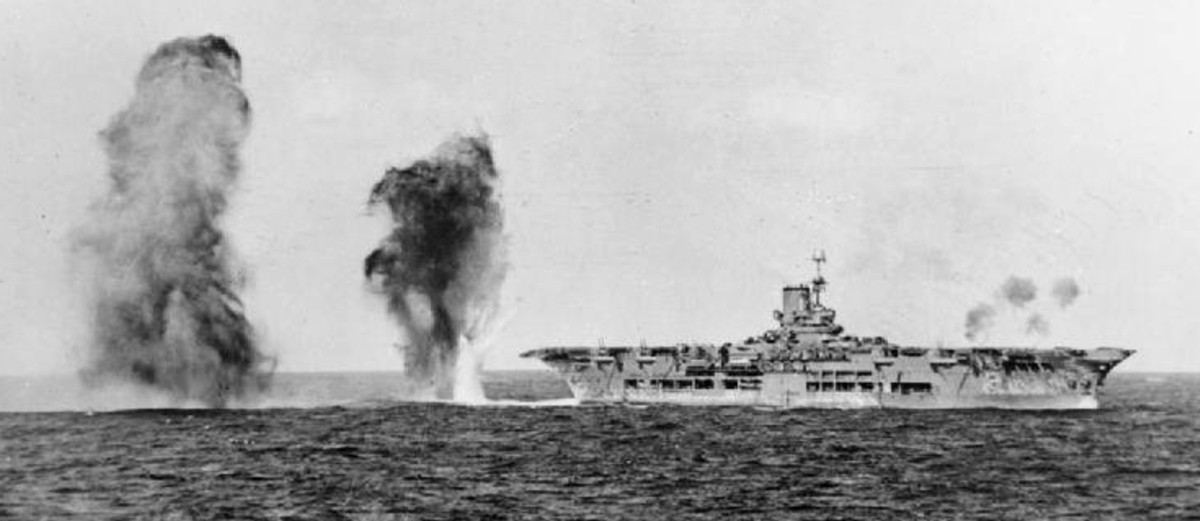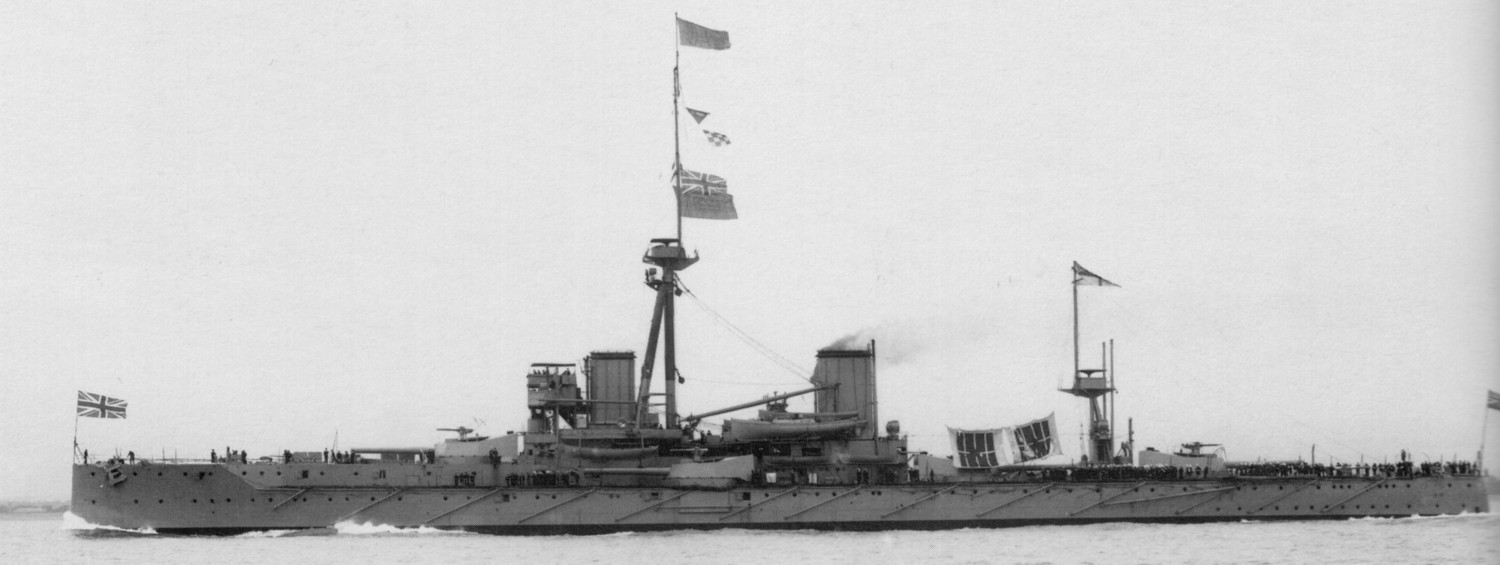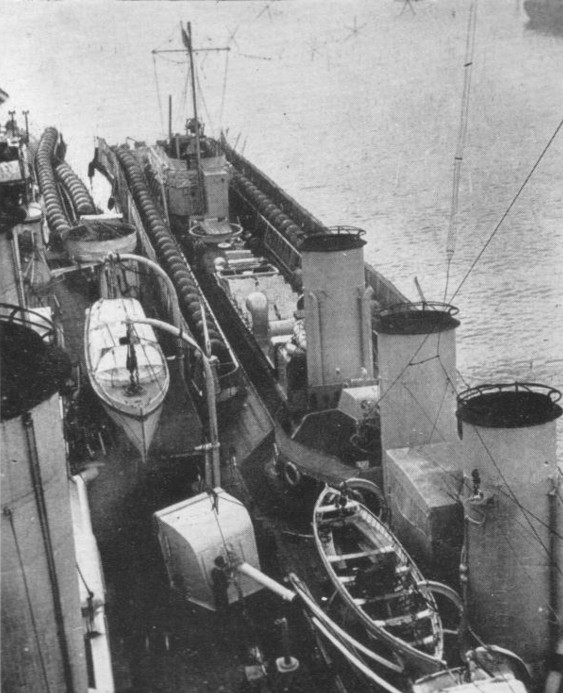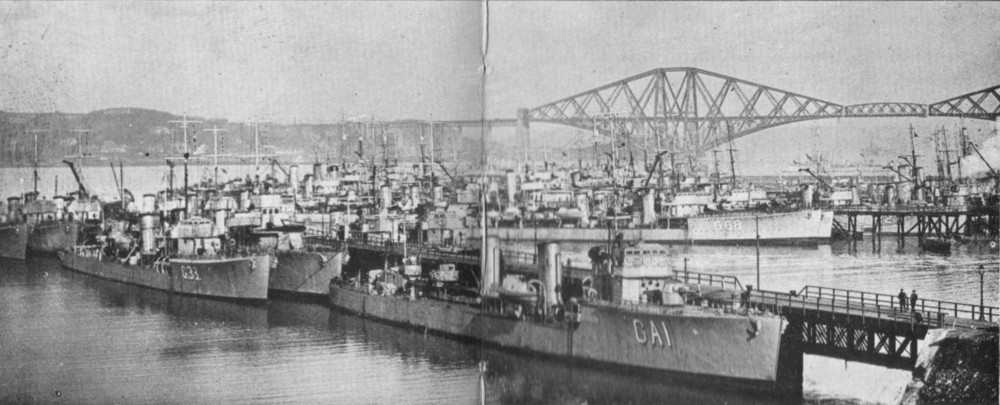
Above: HMS Ark Royal, HMS Malaya, HMS Renown (Force H 1940)
Royal Commonwealth Navy Page:
My original Commonwealth Navy page contained only those drawings
to support the Australis Scenario. I have many theories to support differing
scenarios. If I leave the US as a single entity, rather than splitting it as I
do in the Australis Scenario, then I normally say that the German Scutling at
Scapa Flow does not take place, which releases a lot of German ships into the
South American and other countries (Spain) either as purchases or as war booty.
Germany then gets a less harsh Versailles Treaty which allows Capital Ships at
60% of the 35,000 ton limit with a different set of ships to start the Weimar
Navy. To balance these 'Axis' additions out I create the 'Dominions' early.
Those countries become repositories of ships that are less than 10 years old,
like the Iron Dukes with their 10x13.5", and other modern cruisers and
destroyers. This is what the original Australis idea came from. Germany and
Japan are much more formidable and require more UK Allied forces to fight those
first 2 1/2 years on their own.
Since that original idea I have added many different Alternate Universe,
countries and additional Islands and Lands. I have done a complete rebuild of
the Royal Navy with the Fisherless RN, and I have added a lot of real life and
never-were ships that I am still using to provide the basis for new drawings. I
did two sets of drawings following the design process of the King George V
battleship class and the J,K,N, destroyer classes. Both sets have been added to
with my own personal designs to create even more drawings. I have ended up
creating many hundreds of Royal Navy ships, that may not have otherwise existed
for reasons like being scrapped early, where I have placed the ship with the
Canadian Navy, Australis Navy, South African Navy or even sold some off to South
American countries to create a new 1930's South American Battleship race.
A lot of the early drawings I did for the Australis Scenario look very dated now
(horrible is the word I am looking for I think), so while completely updating
this page I will also update the drawings as well. I will keep the existing
drawings at the bottom of each page so it can be seen how far the skill of pixel
art has advanced since I started drawing these ships 6-7 years ago.
Each ship page will be noted which scenario it belongs to, and where multiple
drawings appear on a page I will note the ideas on each drawing with each
scenario details.
Only those pages I have updated will have the links working. The rest are
still available through this link:
Commonwealth Navies 1939+
The Scenarios:
Australis - Timeline and backstory.
Fisherless RN - ships and reasoning behind:

Above: HMS Ark Royal, HMS Malaya, HMS Renown (Force H 1940)
Aircraft Carriers
The doctrines of the two major Commonwealth CV builders
reflected their major battlegrounds. The Royal Navy required its carriers to be
able to survive near occupied territory in the Mediterranean and along the
coasts of Europe. Its ships were armoured accordingly. The other reason for the
RN to have armoured carriers was the lack of quality aircraft in the Fleet Air
Arm. Upgrade the quality of the FAA aircraft and the RN can have carriers with
lots of aircraft. The Australis carriers
had all the Pacific and Indian Oceans to play in and these areas required
numbers of aircraft aboard as there were no land based aircraft to worry about.
The size of the ships and numbers of aircraft reflected this. For aircraft
carriers, bigger is always better!
HMSAS Kwazulu dodging bombs during an attack from Argentinian bombers during
the
Battle for the Falkand Islands 1939.

|
Class Name |
No. |
First Date |
Country/No. |
Page Address (click on thumbnail or hyperlink for page listing) |
| HMSAS Lesotho |
1 |
1908 |
SA-1 |
 |
| HMS Neptune CVE | 1 | 1911 | UK-1 |
|
| HMAS Manawatu (CVL) | 1 | 1914 | AU-1 |
|
| HMS Revenge (CVE?) | 5 | 1916-17 | UK-5 |
|
| HMS Argus |
1 |
1919 |
UK-1 |
 |
| HMS Hermes |
1 |
1925 |
UK-1 |
|
| HMAS Carpentaria |
1 |
1926 |
AU-1 |
 (Ex Cavendish, Ex Vindictive) (Ex Cavendish, Ex Vindictive)
|
| HMS Furious |
3 |
1925 |
UK-3 |
|
| HMS Eagle |
1 |
1924 |
SA-1 |
 |
| HMAS Van Diemen |
1 |
1928 |
AU-1 |
 |
| HMS Lord Kitchener |
2 |
1928 |
UK-2 |
|
| HMS Goliath/Albion | 1-2 | 1928 | UK-1/2 |
 |
| HMS Illustrious (G3) | 2 | 1929 | UK-2 |
 |
| HMS Apollo | 1 | 1932 | UK-1 |
|
| HMAS Albatross (CVE) |
34 |
1934 |
AU-10, UK-24 |
|
| HMS Ark Royal |
4 |
1938+ |
UK3 SA-1 |
.png) |
| HMS Andania | 6 | 1921-40 | UK-6 |
.png) |
| HMS Albatross (CVL) |
10 |
1940 |
UK-6 |
.png) |
| HMS Illustrious |
5 |
1940 |
UK-5 |
|
| HMAS Endeavour |
4 |
1941 |
AU-4 |
.jpg) |
| HMS Unicorn / HMAS Tasman | 16 | 1942 | UK-AU |
|
| HMS Audacious |
4 |
1944 |
UK-4 |
 |
| HMS Indefatigable/Malta |
2 |
1944-45 |
UK-4 |
 |
| Fleet Air Arm | Lots | 1938-45 | Everyone |
|
Battleships / Battlecruisers
Even though the Commonwealth navies were acting in concert for
building of their capital ships, you can see from the list below that no real
homogenous classes of battleship or battlecruiser emerged. The closest would be
the King George and Westralis types which shared the same hull if not the same
armament and were supposed to have been 6 UK and 4 Australis for a total of 10.
The Temeraire class of 4 laid down in 1938/39 were delayed, cancelled and
scrapped from wars outbreak. (All of this changes from week to week as I dream
up more and more differing scenarios and drawings to populate this section). Of
the remaining four Invincible and Indefatigable class battlecruisers at WW1's
end, the two Invincible were given to Chile as part of their replacement package
and the other two were sold to Brazil.
I have produced a lot of Royal Commonwealth drawings of
battleships and battlecruisers under the "Special Projects" banner. The job now
is to integrate those ships into the Royal Commonwealth timeline. Also I will
try and seperate out the pages where I have three or four different sets of
ships in one page. e.g. The King George V series. The Special Project Ships I
will mark in red.
Looking through the ships (BB/BC) that I have in these pages. I would
say only about half might have had any part to play in WW2. There are a lot of
groups of ships where only one class would have been built. Such as the Majestic
/ Hood / Incomparable / Indefatigable / Nelson / Nelson / Anson / Howe /
Invincible, only one type would be the real life Nelson / Rodney replacements.
The Battle Cruiser Squadron at sea, Jutland 1916. (Tiger, Princess Royal,
Lion), the Splendid Cats.

Area Defence Vessels / Pre-Dreadnoughts / Armoured Cruisers / Training Ships
Along with their primary duties these ships operated as depot/repair ships
for minor war vessels. The two operating from Sierra Leone never got to sea as
they were used for depot and repair ships for the escorts and seaplanes working
from the base. They were indispensable. But the same rules apply to the ADV's as
to the older cruisers in the next grouping. How old is too old? I have been
keeping older armoured cruisers and pre-dreadnoughts where there are plenty of
the almost as old dreadnoughts. The most advantageous bit of keeping the later
ships. The later ships have turbines, the older ships, triple expansion engines.
The ADV's had only to be powered enough to be able to pass from one port to the
next, but they had to be reliable. Also the bigger early BB's gave more room for
fitting all the repair and refit facilities than the older ships.

|
Class Name |
No. | First Date |
Country/No. |
Page Address |
| HMS Dreadnought (BB) | 1 | 1906 | UK-1 |
|
| HMS Dreadnought (BB) Superimposed | 1 | 1906 | UK-1 |
|
| 1 | 1908 | SA-1 | ||
| 2 | 1909 | AU-2 | ||
| HMS Bellerophon (BB) | 3 | 1909 | UK-3 |
|
| 2 | 1910 | UK-2 | ||
| 1 | 1913 | AU-1 | ||
| 1 | 1935 | SA-1 |
Heavy - Light - Anti-Aircraft Cruisers

Join the Navy and see the world! Two D Class cruisers and Hood go around the
world.
Commonwealth cruisers fought battles from the freezing seas of the Arctic to the heat of the East Indies, against surface and air threats alike.
The early cruisers built from 1914-1920 were of great importance to the
Commonwealth Navies for the work they carried out on secondary duties. Without
them a first line cruiser would have had to be employed to do the same job and
the Commonwealth never had enough cruisers. But in saying that, how far back in
time should the cruisers be kept from. The 'Scouts' from 1909-10 would be 30
years old at the start of WW2, to me that is too old, especially after the hard
war the scouts had. Those scout cruisers are more likely to end up in the most
minor navies such as Thailand and other third tier fleets. The Bristols and
Weymouths are sold off/ given to South American Navies to balance the
Argentinian acquisitions. To my mind, the oldest cruisers likely to be kept in
service are the Chatham, Birmingham, Arethusa classes from 1913-14 age groups.
Those ships will populate the other Commonwealth Navies. For those ships I coin
the term 'Escort Cruiser'. They are very useful as Convoy Commander cruisers.
The cruiser evolution from WW1 to WW2 runs from completing the D Class cruisers
(including the four that were cancelled and broken up), and E Class cruisers,
still not sure what to do with the Frobisher class, then we get into the County
and Exeter heavies, the return of the 6" cruiser. A lot of work is done through
the 1930's on keeping the older cruisers up to date till 1936-37 when the C & D
class cruisers start being converted to AA cruisers. The WW2 built cruisers are
standardised on the three types, a 10 gun AA cruiser, a light cruiser with 9x6",
and the 9x8" heavy cruisers. The Princess Royal class of 1944-45 stay in the RN
right through the 1970's and early 80's.
Destroyer (Leader - Escort) Minelayers

Marksman DDL with Light Cruiser alongside, both ships armed with mines.
The Commonwealths destroyer flotillas went everywhere and served there with distinction and courage. This class of ship had more comparative losses than any other type. The biggest problem is to figure out which of the WW1 classes would remain in Commonwealth service through to WW2. The 'M' class started completing in 1914 and the bulk had been completed by 1916 the M's had a hard war and did most things at full speed. By the end of WW1 a lot of these cheaply produced units were already worn out and all of the class was sold or discarded by 1925. Then the 'R' class came online in 1916-17, with the 'S' class following on from the 'R's. These two classes fed the Commonwealth need for escort destroyers and those that were still available in WW2 provided excellent service in that role. Various 'Leader' units were built 1916-1922, some were still in service for WW2 and were useful, still, as destroyer leaders. The bulk of the inter-war destroyer flotillas were made up of the VW class destroyers. The major inter-war construction was the A-I classes. Then the upgraded and uprated J-N class ships were built utilising the latest 4.5" turret guns. Along side these ships were the four squadrons of Tribal class destroyers which sacrificed a set of torpedoes for an extra turret of 4.5". That took the destroyer construction up to the start of WW2 when the Admiralty put into place the 'War Emergency Construction' destroyer units. The first 'O-P' classes were armed with Mk XVI twin open 4" mountings while the larger Q to C classes were fitted with two twin 4.5" mountings which allowed for lots of minor AA and electronics being fitted.
|
Class Name |
No. | First Date |
Country/No. |
Page Address |
| 32 | 1916-17 | SA-12 / UK-20 | ||
| 57 | 1918 | AU-24/SA-12/UK-30 | ||
| 18 | 1915 | AU-4, UK-14 |
|
|
| 80 | 1917 | AU-12/UK-60/SA-8 | ||
| 16 | 1917-20 | AU-4/UK-12 | ||
| HMS Mars (DDL) | 6 | 1926-30 | UK-6 |
|
| 108 | 1924-40 | SA-10/UK-66/AU-32 | ||
| 16 | 1929+ | AU-4/UK-12 |
|
|
| HMS Afridi (DDL) (Tribal Class) | 36 | 1937 | AU-8/SA-4/UK-24 | |
| 60 | 1938 | SA-4/UK-48/AU-8 | ||
| HMS Brissenden (Hunt Class-DDE) | 102 | 1940 | AU-16/UK-86 | |
| HMS Onslow (O-P class-DD) | 24 | 1940-41 | AU-4/SA-4/UK-16 |
|
| 126 | 1942+ | SA-16/UK-110 | ||
| 120 | 1942-46 | AU-16/SA-8/UK-108 | ||
| 24 | 1945 | UK-24 | ||
|
MINELAYERS |
||||
| 2 | 1906 | SA-2 | ||
| 2 | 1914 | AU-2 | ||
| 2 | 1924 | UK-2 | ||
| 10 | 1938 | UK-8 AU-2 | ||
| 2 | 1943 | SA-2 | ||

Destroyer pens on Firth of Forth 1916-17.
Minesweepers - Sloops - Frigates - Corvettes - Escorts - Gunboats - MTB's - MGB's
The Commonwealth produced over 800 escort vessel types during WW2, a staggering amount, and if you asked, there were never enough.
The problem with the UK escort in real life is the
Flower class corvettes. They are really just too slow. That is not a comment on
the men who manned them - it took a certain type of courage to go to sea in
corvettes. Recommended reading is the novel 'The Cruel Sea' by Nicholas
Montserat. By too slow I mean exactly that - most corvettes made 14-15 knots
depending on how clean the hull was. If their convoy is doing 8 knots and the
corvette spots and is given permission to hunt a U-boat contact for 6 hours.
Once the contact is resolved then the ship has to catch up to its convoys. Eight
hours later (at full speed)...... the convoy has been decimated in a U-boat
wolfpack attack. The weaker escort has produced holes in the cover the U-boats
just sail through. That is worst case scenario, but even running at full speed
could cause breakdowns trying to get back to the convoy. The only way to go is
with a bigger, faster, escort than a corvette. What had always surprised me is
that the Admiralty still had the plans for the Flower class sloops of WW1
vintage. They were certainly big enough to have the required range and with
updated propulsion equipment, speed could have been raised to around 20 knots
which would have been enough for the slow 8-12 knot convoys. The faster 15+ knot
convoys and troopers would require the faster escorts anyway. Which leads on to
the bigger Frigate classes (River/Bay/Loch) all at about 24 knots and much more
capable. The US built DDE/FFG units were of a very similar concept to the UK
Frigates the only difference between the designations DDE and FFG was that the
DDE carried a triple torpedo tube mounting and the FFG did not.
But that is 20 years in the future. 1919 and the Royal Navy has to divest itself
of 100's of ships that were so important to the safety of the Empire just months
ago. All of the ships that could be sold out to merchant service (to help
replace the losses caused by the war), were sold on. Hundreds of thousands of
tons of shipping of all sizes were just scrapped. Lots more 'escort' type ships
of all flavours were 'sold' to the new Dominions, leaving just a core of basic
units to be used around the Empire fleets. Flower class Sloops, Hunt/Aberdare
minelayers, those were the ships that lasted through till WW2, the rest having
been sold or scrapped. Replacements for the WW1 ships, still in service, were
not really contemplated till the early 1930's. Part of the London Naval Treaty
of 1930 was the proviso for an unlimited number of vessels under 600 tons. This
lead to trials with the Kingfisher class corvettes. They were not a success. Too
much tried on too little. Stability was a major issue from day one and never got
any better. A second escort type was also trialed, the coastal
escort/minesweeper Bangor class also of 600 tons. These were much more
successful and the type was carried on with into WW2 building plans and around
the Dominions. The Hunt/Aberdare types were being replaced from the mid 1930's
by the new Fleet minesweepers of the Halcyon class. The Sloop/Gunboat classes
were important for all sorts of jobs around the Empire - chasing pirates around
the China Seas, coastal escort work around Africa and India, etc. The main
problem with Escorts for WW2 was to take them out of the Naval Yards for
building and into the mercantile builders sector. That is where my thought for a
revamped WW1 Flower class Sloop rather than the real life corvettes comes into
play.
|
Class Name |
Type | No. | First Date |
Country/No. |
Page Address |
| MS | 34 | 1917+ | AU-8/SA-4/ZA-4/UK-18 | ||
| MS | 18 | 1934+ | UK-21 | ||
| MS | 78 | 1937+ | UK-70/SA-8 |
|
|
| MS | 64 | 1934+ | AU-64 | ||
| HMS Algerine | MS | 124 | 1941+ | UK-90/SA-34 |
|
| ES | 9 | 1935 | UK-9 | ||
| ES | 311 | 1940+ | UK-219 / SA-48 / AU-32 / Z-12 | ||
| FG | 270 | 1940 | AU-48/SA-24/UK-198 | ||
| Shoreham Class | SL | 15 | 1932+ |
UK-12 / AU-2 / IN-1 |
|
| SL | 70 |
1935+ |
UK-54/AU-12/SA-4 |
|
|
| Vosper MTB/MGB | MTB | 480 | 1938+ |
UK-380/100-rest |
|
| Fairmile MTB/MGB | MTB | 1000 | 1940+ |
UK-750/250-rest |
Miscelaneous (Monitors - FRS)
With the outbreak of war the Royal Navy ceased building specific repair/depot
ships and started converting civilian and older warships to fill those needs.
The
Royal Navy did not need Fleet Replenishment Ships as used by Australis till
their ships started operating in the Pacific Theater when they utilised the
Australis ships and converted civilian ships.
Real timeline monitors made use of the two unused turrets from Repulse / Renown
being reordered from the R class (8x15") to battlecruisers with 6x15", and the
two spare 15" turrets built for the Furious in case the 18" did not work aboard
that ship.
It is interesting to follow the disposition of these four turrets.
Repulse -> Marshal Ney -> Abercrombie 42
Renown -> Marshal Soult -> Erebus
Furious1 -> Terror
Furious2 -> Roberts 42
For the Fisherless RN, the Courageous, Glorious and Furious do not get built. So
no extra 15" turrets for the Vanguard. No extra 18" turrets (three) or spare 15"
(two built as spares) that could be used for monitors or later placed at
Singapore. I use the 5 x 'R' class armour/armament to produce a new
Admiral
class stream (1939). So where do I get the twin 15" turrets for the WW1 and WW2 monitors of
the Marshal, Erebus and Roberts classes. The original R class was supposed to be
7 ships with only 5 being built, the final two being replaced with the
Repulse/Renown. In the Fisherless RN the Repulse and
Renown also disappear, those two ships are cancelled an reordered as the Barfleur Class with triple 15". So that leaves two cancelled R's and their eight
twin 15" to dispose of. For my AU that gives two Marshal Class and four Erebus
class, the final pair of turrets being kept as spares for the ten R class and
Queen Elizabeth class. In real life there was a third Erebus class ship being
built that was cancelled and scrapped in 1918-19. The four twin 14" provided by
the US and used for monitors, three turrets were returned in 1919 the fourth
being sunk aboard HMS Raglan in 1918 by the battlecruiser Goeben/Yavuz. The two
spare 15" turrets are used to build the Abercrombie and Roberts following the loss of
the Marshal Ney (1940) and Terror (1941).
|
Class Name |
No. | First Date |
Country/No. |
Page Address |
| 2 | 1915 | UK-2 | ||
| 4 | 1916-1918 | UK-4 | ||
| 1 | 1918 | SA-1 | ||
| 2 | 1918 | UK-2 | ||
| 5 | 1929 | AU-5 | ||
| HMS Skirmisher | 4 | 1928-32 | UK-4 |
|
| 2 | 1938 | AU-2 | ||
| 2 | 1939 | SA-2 | ||
| 2 | 1941 | UK-2 | ||
| HMS Prince Robert | 5 | 1941 | UK-5 |
|
| HMS Laconia | 83 | 1939+ | UK-NZ-AU-SA |
|
| 9 | 1943+ | SA-9 |